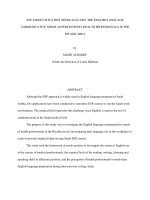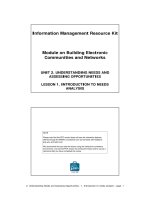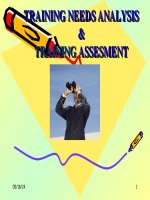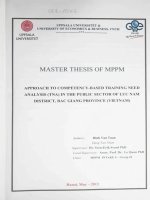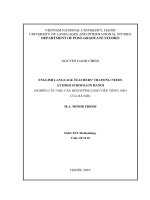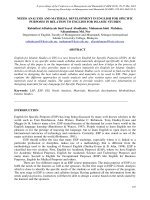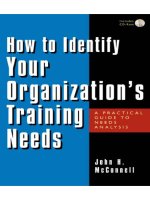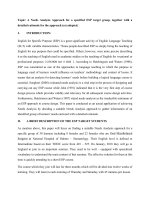Training-Needs-Analysis
Bạn đang xem bản rút gọn của tài liệu. Xem và tải ngay bản đầy đủ của tài liệu tại đây (526.66 KB, 16 trang )
Training Needs Analysis
A Guide for the Construction
Industry
0
Training Needs Analysis in the Construction Industry
CONTENTS
About this guide ..................................................................................................................................................... 2
How this guide is organised .................................................................................................................................... 2
What is a Training Needs Analysis? ........................................................................................................................ 3
The Training Needs Analysis (TNA) process ............................................................................................................ 3
The 4 levels of needs analysis ................................................................................................................................. 4
1. Legislative analysis .......................................................................................................................................... 4
2. Organisation analysis ...................................................................................................................................... 4
3. Job Analysis ..................................................................................................................................................... 4
4. Personal analysis............................................................................................................................................. 4
Step1. Collecting diverse data ................................................................................................................................ 5
Job performance ................................................................................................................................................. 5
Task observation ................................................................................................................................................. 5
Critical incidents ................................................................................................................................................. 5
Interview ............................................................................................................................................................. 5
Questionnaire method ....................................................................................................................................... 6
Defining: Knowledge, Skills, Attributes and Competencies .................................................................................... 6
Knowledge .......................................................................................................................................................... 6
Skills .................................................................................................................................................................... 6
Attributes ............................................................................................................................................................ 6
competency ........................................................................................................................................................ 7
How to analyse data and identify needs/gaps ....................................................................................................... 8
Sample Organisation analysis Template ......................................................................................................... 8
Job & legislative analysis .................................................................................................................................... 9
Sample Job & Legislative requirements template .......................................................................................... 9
Sample Task analysis template (Knowledge, Skills and Attributes template) .............................................. 10
Personal skills analysis ...................................................................................................................................... 11
Sample Position skills audit template ........................................................................................................... 12
Sample Training Needs Analysis Template ................................................................................................... 13
Sample Learning and development plan ...................................................................................................... 14
TNA checklist ........................................................................................................................................................ 15
1
Training Needs Analysis in the Construction Industry
ABOUT THIS GUIDE
The purpose of this guide is to assist you with assessing whether your organisation’s employees, contractors or
workers have the adequate knowledge, skills, qualifications, licenses and mandatory requirements to perform
their job function safely, effectively and efficiently.
This guide will provide you with samples and a process to assist in the identification, analysis and conduct of a
Training Need Analysis (TNA) with the outcome of developing a robust work, health and safety or equivalent
occupational health and safety training matrix or general training matrix.
HOW THIS GUIDE IS ORGANISED
This guide outlines:
Why it is important to conduct a regular TNA,
How to conduct a TNA,
An introductory statement for each step, a process flow, as well as templates to record and collate
the analysis,
A description of each of the four levels of a TNA,
Sample templates that can be amended to suit your organisation,
Reflective questions to consider when working through a TNA,
Example working training matrix tool.
2
Training Needs Analysis in the Construction Industry
WHAT IS A TRAINING NEEDS ANALYSIS?
Analysis: The study we do in order to figure out what to do. - Allison Rossett & Kendra Sheldon (2001).
A Training Needs Analysis (TNA) is the process used to identify the training and development needs of your
employees (all trades, professions, employees and contractors), so that they can carry out their job effectively,
safely and efficiently, and develop their careers (sucession planning).
The TNA considers the skills, knowledge and attributes (behaviours) that your people need and how to identify
and develop them effectively. The outcome of your TNA should be a robust learning and development plan,
based on identified requirements and linked to organisational, team and individual objectives.
When carried out effectively, a TNA will have many positive effects for your organisation, teams and
individuals, as the training which follows as a result of the TNA should be relevant and meet their development
needs.
THE TRAINING NEEDS ANALYSIS (TNA) PROCESS
The TNA process is about gathering information to identify gaps between job knowledge and skills required
now or for future employment needs and the current knowledge and skills of an employee or group of
employees. It starts with collecting information against the four levels of needs (legislation, organisation, job
and individual needs). Once the information has been collected, it is then analysed using a variety of sample
templates (located in this document). The needs/gaps are identified and categorised into learning
opportunities or non-learning opportunities as per the diagram below.
3
Training Needs Analysis in the Construction Industry
THE 4 LEVELS OF NEEDS ANALYSIS
A TNA covers four levels of needs. These are inter‐linked and using this structure will help ensure a balanced
analysis that takes into account the big picture as well as the specific needs of an individual(s).
At one end of the scale, a TNA can mean a comprehensive analysis of all training and development needs
across an entire organisation to meet their strategic goals. A TNA can also be used to analyse the legislative
and regulatory requirements of a role as well as the skills, knowledge and attributes required to successfully
meet the role. It can also be used to provide a detailed analysis of one individual’s training and development
requirements as outlined below.
1. LEGISLATIVE ANALYSIS
This relates to legislative and regulatory requirements, including tickets of competency, licenses and
qualifications that the construction industry requires. This level also incorporates information about new
legislation or regulatory requirements that impact on an organisation, project, person and job.
2. ORGANISATION ANALYSIS
This relates to the needs of the organisation or company as a whole, identifying where training should be used
to achieve organisational goals, objectives, targets and business planning. This level views training needs in the
context of what an organisation needs.
3. JOB ANALYSIS
This relates to the needs of specific jobs within an organisation and uses information about jobs to develop
standards of performance that identify the necessary licenses, legislative and regulatory requirements,
knowledge, skills and attributes to achieve the desired standards of performance. This level views training in
terms of jobs which together make up an organisation.
4. PERSONAL ANALYSIS
This relates to the needs of individuals within an organisations and the adequacy of their competency level to
perform their job requirements. This level views training in terms of individuals who collectively make up the
organisation.
Regardless of what level of analysis you are performing, the questions you will need to answer include:
Does a performance problem exist?
Does the individual know how to do their job?
Does the individual know the standards required for their job?
Does the individual know the systems, processes and forms required?
Does the individual know the legislatative, regulations or codes that impact their work?
What are the training related parts required for their job?
What are the gaps if any?
Why is there a gap?
What are the causes of the gap?
What are the consequences of the gaps?
What content is required in the training?
What are the consequences of not indentifying and implementing the training?
Is there a training need?
What are the parameters of the problem, need and tasks?
What are the most important areas to deal with first?
4
Training Needs Analysis in the Construction Industry
This TNA guide will take you through the steps and provide you with templates to take you through the four
levels of analysis and provides you with sample templates to assist you in the process.
COLLECTING DIVERSE DATA
A variety of methods are used to collect information about jobs, as no one way of collecting data is perfect. A
combination of several methods may be used to ensure accurate information collection. Some of these
methods are discussed below.
JOB PERFORMANCE
In this method, the job analyst (person responsible for analysing the job) actually performs the job in question.
The analyst therefore receives firsthand experience of all aspects of the job including physical hazards, social
demands, emotional pressures and mental requirements. This method is useful for jobs that can be easily
learned. It is not suitable for jobs that are hazardous or for jobs that require extensive training.
TASK OBSERVATION
This method requires the task analyst to observe the worker(s) doing the job. The tasks performed, the pace at
which tasks are completed, the working conditions and other factors are observed during a complete job task
cycle. During observation, certain precautions should be taken, such as:
The analyst must observe average workers during average conditions,
The analyst should observe without getting directly involved in the job,
The analyst must make note of the specific job needs and not the behaviours specific to particular
workers, and
The analyst must make sure that he obtains a proper sample for generalisation.
This method allows for a deep understanding of job duties. It is appropriate for manual, short period job
activities as well. It is important to note that the methods fail to take note of the mental aspects of a job role
and this is where consideration for various external factors such as fatigue and stress need further analysis.
CRITICAL INCIDENTS
The Critical Incident Technique (CIT) is a qualitative approach to job analysis used to obtain specific,
behavioural focused descriptions of work or other activities. Here, the job holders are asked to describe
several incidents based on their past experience. The incidents collected are analysed and classified according
to the job areas they describe. The job requirements will become clear once the analyst draws the line
between effective and ineffective behaviours of workers on the job. The critical incidents are recorded after
the events have already taken place, both routine and non-routine. The process of collecting a good number of
incidents is a lengthy one.
INTERVIEW
The interview method consists of asking questions to both incumbents and supervisors/foreman/managers in
either an individual or a group setting. The reason behind the use of this method is that job holders are most
familiar with the job and can supplement the information obtained through observation. Workers know the
specific duties of the job and supervisors are aware of the job's relationship to the rest of the organisation.
Caution must be exercised when using this interview method. The interviewer must be trained in proper
interviewing techniques. It is advisable to use a standard format to focus the interview to the purpose of
analysis.
5
Training Needs Analysis in the Construction Industry
Although the interview method provides opportunities to elicit information sometimes not available through
other methods, it has limitations. First, it is time consuming and therefore costly. Second, the value of data
collected is primarily dependent on the interviewer's skills and may be faulty if they put ambiguous or unclear
questions to workers. Lastly, interviewees may be suspicious about the motives and may distort the
information they provide. For instance, if seen as an opportunity to improve their employment positions,
workers may exaggerate their job duties.
QUESTIONNAIRE METHOD
The questionnaire is a widely used method of analysing jobs and work. Here, the job holders are given a
questionnaire aimed at collecting relevant job-related information. After completion, the questionnaires are
analysed.
The success of the method depends on various factors. The structured questionnaire must cover all job related
tasks and behaviours. Each task or behaviour should be described in terms of features such as importance,
difficulty, frequency, and relationship to overall performance. The job holders should be asked to properly rate
the various job factors and communicate this on paper.
The questionnaire method is highly economical as it covers a large number of job holders at a time. The
collected data can be quantified and processed through a computer. The participants can complete the items
leisurely. Designing questionnaires, however, is not an easy task. Proper care must be taken to see that the
respondents do not misinterpret the questions. Further, it is difficult to motivate the participants to complete
the questionnaires truthfully and to return them.
DEFINING: KNOWLEDGE, SKILLS, ATTRIBUTES AND COMPETENCIES
For the purpose of this guide the terms knowledge, skills, attributes and competencies are defined:
KNOWLEDGE refers to a body of information that a person needs in order to perform a particular job. It can
include the completion of university or nationally recognised vocational qualifications, trade certificates,
licences and tickets, knowledge of how to perform particular job tasks (i.e. procedural knowledge), or
knowledge of rules and regulations, e.g. understanding and following Safe Work Method Statements (SWMS)
or conducting a risk assessment using risk scoring or risk ranking.
SKILLS refer to the observable behaviours a person needs to carry out work tasks. Skills are usually gained
through previous or current job experience or vocational training.
ATTRIBUTES
refer to the physical or mental capabilities or aptitudes required by the person in the job.
Attributes are an individual's potential to develop the necessary skills for the job, and most skills require
usually one or more associated or underlying abilities. Other Attributes include values, interests, attitudes, or
personal style needed by the person in order to cope with the conditions of the job. It may also include the
tools and equipment used while performing the job, or special certifications that the worker should have.
6
Training Needs Analysis in the Construction Industry
COMPETENCY is the capability to apply or use a set of related knowledge, skills, and abilities required to
successfully perform "critical work functions" or tasks in a defined work setting. Competencies often serve as
the basis for skill standards that specify the level of knowledge, skills, and abilities required for success in the
workplace as well as potential measurement criteria for assessing competency attainment.
McIntyre, Bucklan, & Scott, 1995; Spector, 1996
7
Training Needs Analysis in the Construction Industry
HOW TO ANALYSE DATA AND IDENTIFY NEEDS/GAPS
Organisation Analysis:
Consult
with others
to identify
the goals
Collect
supporting
document
Identify the
core
competency
requirement
across roles
to acheive
these goals
Identify the
positions
you need
to achieve
these goals
Match the
positons to
the
competency
Use the Job
Analysis
template to
analise the
skills,
knowledge
and
attribtue
each
positon will
need
Update the
Organisation
Analysis
template
The purpose of the Organisation Analysis Template is to identify and record what skills / knowledge are
required to enable the organisation to meet its objectives / vision.
SAMPLE ORGANISATION ANALYSIS TEMPLATE
Position
Position
Position
Position
Position
Position
8
Training Needs Analysis in the Construction Industry
Core competency
Core competency
Core competency
Core competency
Core competency
Core competency
Team Goal
Core competency
Core competency
Core competency
Core competency
O = high
X = low
Departmental/Project
Goals
Core competency
Organisation Strategic
Goal:
JOB & LEGISLATIVE ANALYSIS
Collect Job
description
and other
support job
related
documents
Identify the
goals and
objectives of
the position
Identify
knowledge
/skills
required to do
the job
Identify any
physical
requirements
for the
position
Complete the
Job Analysis
template
Use the task
analysis
template to
gather more
indepth
information
from SMEs
Update the
Functional
Skills Audit
template
The purpose of a job analysis template is to document the requirements of a job and the work performed.
The purpose of a task analysis template is to document the skills, knowledge standard performance and legislative
requirements required to complete a task safely and on time.
SAMPLE JOB & LEGISLATIVE REQUIREMENTS TEMPLATE
Date:
Title:
Prepared by:
Department:
Understanding the job
Goals and Objectives of the position
Knowledge/Skills/Attributes required
Legislative and regulatory requirements
Additional requirements
Core Competencies
Essential
Significant
Learn on the Job
Circle and attach the evidence you used to conduct this job analysis.
Position descriptions
Industry best practice
information
Performance review
documents
Other (please specify)
9
Training Needs Analysis in the Construction Industry
Legal and regulatory
information
SAMPLE TASK ANALYSIS TEMPLATE (KNOWLEDGE, SKILLS AND ATTRIBUTES TEMPLATE)
Prepared by:
Date:
Position Title:
Goals and Objectives of the position:
Task
10
Department:
Knowledge
Training Needs Analysis in the Construction Industry
Skills
Standard Performance
PERSONAL SKILLS ANALYSIS
Identify the
competencies
and descriptions
that relate
specifically to the
role.
Indentify the
competencies
already held
Use the Position
Skills Audit
template to
record emloyee
competencies
against required
competencies
Complete the
Training Needs
Analysis template
Complete the
Learning and
Development
template
The main purpose for conducting a skills audit is to identify the skills and knowledge that the organisation
requires, as well as the skills and knowledge that the organisation currently has.
The purpose of a TNA is to identify and document any knowledge or skills gaps an employee has and identify ways
of addressing these gaps
The Learning and Development Plan documents the how, when and where this training will take place.
Some questions to ask during this stage :
What do you want to get from your work?
What are your strengths?
What areas would you like to improve?
Where would you like more responsibility?
What is preventing you from developing as you would like?
Which interests or talents would you like to develop?
How do you like to learn?
What skills or experience would allow you to feel more confident at work?
11
Training Needs Analysis in the Construction Industry
SAMPLE POSITION SKILLS AUDIT TEMPLATE
Employee Name:
Qualifications:
Position Title:
Self-Assessment by
employee
Competency
Description
Have
Now
Need Required
Now in Future
Validation of Competency
Date
Evaluation
Initials Method
(see keys)
below)
Please use the following Evaluations Method keys :
O
D
W
Q
C
12
Training Needs Analysis in the Construction Industry
Observation
Demonstration
Written Test
Qualification
Certificate
SAMPLE TRAINING NEEDS ANALYSIS TEMPLATE
Employee Name:
Position Title:
Purpose:
Major job tasks for the
position
Training/skills
development
required?
Yes
No
If yes identify what
training needs
exist.
How will this
be achieved?
(e.g. on the
job, external
training
What do we want to achieve in the period ahead?
Where can you/we see your career moving in the next two years?
How are we going to make this happen?
What will you need from the company to assist you to reach your career goals?
13
Training Needs Analysis in the Construction Industry
When?
Who to
organise?
Training
provider?
SAMPLE LEARNING AND DEVELOPMENT PLAN
Organisation
goal
14
Knowledge
and skills
required
Who will
participant
Learning and
development
activities
How will this
be evaluated
Training Needs Analysis in the Construction Industry
Cost
Date
TNA CHECKLIST
Your Training Needs Analysis should consider the following:
Is it a training need or an organisational systemic issue?
Know what your organisation, project and team is trying to accomplish in general
and in alignment to organisational business plans/objectives/visions.
Know the history of training within the organisation.
What needs are being addressed by the training?
Are there any recent process or procedure changes?
What are the legislative and regulatory requirements that must be adhered? (By
job function and organisationally)
What resources are available to conduct the training?
Who needs to be trained, how often and what is the priority?
Who can serve as subject matter experts?
How will the training be conducted?
Are there budget constraints or an allocated budget?
Which companies provide training if an external provider will be used?
What are the knowledge, skills, and abilities?
Review Job Descriptions and Organisational Charts.
Undertake a review process with key stakeholders.
Develop a communication strategy with key stakeholders.
Agree and endorse with sign off on the TNA.
Convert the TNA to a matrix which is easily understood by all stakeholders and can
be easily audited.
15
Training Needs Analysis in the Construction Industry
